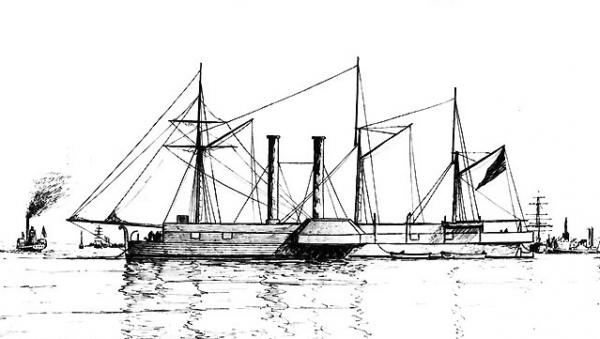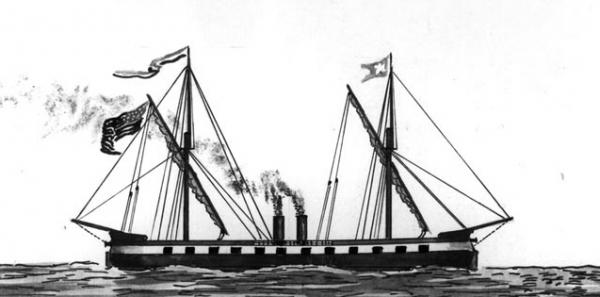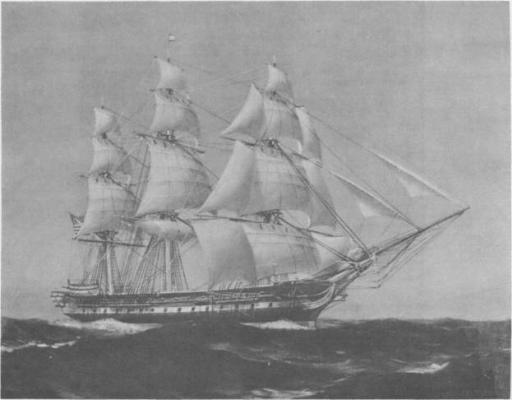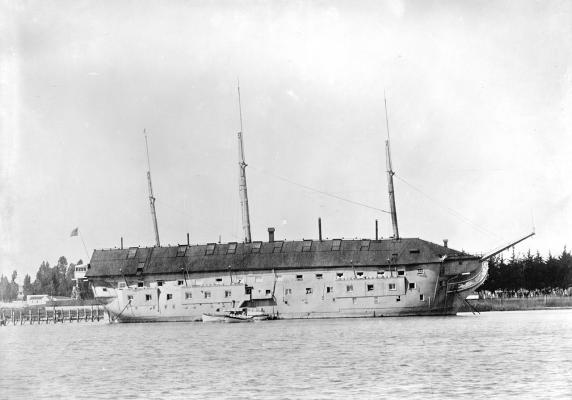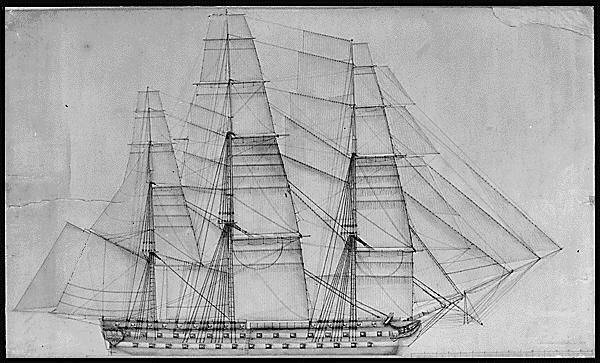-
Posts
455 -
Joined
-
Last visited
Content Type
Profiles
Forums
Gallery
Events
Everything posted by molasses
-
Name the Ship: The two stacks shadow two more stacks next to them, four total. Image cropped but otherwise unchanged.
-
Lemoyne (1926-1969) for many years was the largest bulk carrier on the Lakes and the first with a beam of 70 feet.
-
Wayne, you are correct, it is the USS Fulton. Designed by Robert Fulton as Demologos, Congress authorized her construction during the War of 1812. Commissioned as Fulton after Fulton's death, she made successful trial runs in the summer of 1815. The two masts and lateen sails were added by her first captain, David Porter. With the end of the war it was decided not to fully outfit her for her intended duty as a port defense battery ship. Her one day of active service occurred with President James Monroe on board for a tour of New York Harbor before she was placed in ordinary in 1816. In 1825, she was housed over and used as a receiving/barracks ship until she was destroyed by a magazine explosion in 1829, killing 30 men. Fulton was the first steam warship (and one of only a handful of steam ships that actually worked) and demonstrated a future for naval warfare in which warships would be able to operate independently of the wind. It took another 30 years and several other inventions (like the screw propeller) before steam warships began to realize their potential. A few, at least, recognized what they saw during Fulton's trials, in spite of its flaws, and called this ship "Fulton the First". Your turn, Wayne
-
I was not happy with changing my design by eliminating the channels - I was looking forward to doing them and their associated details. I also wasn't pleased with my bottle either because of the rough surface finish and thickness irregularities that will cause distortion of the view of the ship inside. This flippant comment got me thinking. After an internet search and e-mailing a few glassblowers in the Los Angeles area (I live in the desert east of LA) I decided this was the way to solve both of my problems. I continued work on Ogallala, as designed with channels, while finalizing the details of getting my bottle made. Today I ordered a custom bottle of similar size to the gallon jug but with a larger opening and, except for the pain in my wallet (yes, it is expensive), I'm happy about it. I'm excited about getting glass that will be much better than that ugly gallon jug.
- 170 replies
-
- ogallala
- praire schooner
-
(and 2 more)
Tagged with:
-
Thanks, Kevin. Where do I know you from?
- 170 replies
-
- ogallala
- praire schooner
-
(and 2 more)
Tagged with:
-
-
USS Buchanan / HMS Cambeltown. I'll leave it to Kevin to tell us her remarkable story.
-
Independence is correct, Kevin. Independence, 90 x 32 pound guns and the first ship of the line of the United States Navy, was built in time to assist Constitution in defending Boston Harbor during the Anglo-American War of 1812. After the war Independence served as flagship of the Mediterranean Squadron which joined with Stephen Decatur's squadron in a show of strength after Decatur's success in defeating the North African pirate states in the Second Barbary War. Independence, which had an acknowledged problem with riding too low in the water to open the lower deck gunports in even moderate seas, was razeed in 1836 to a very heavy "frigate" armed with 54 x 32 pound guns. This change greatly improved her speed and seaworthiness making her the fastest ship in the US Navy. She served as flagship on several stations (in one case being chosen over the new three-decked Pennsylvania) until 1857 when she was assigned duty as the receiving ship at Mare Island Navy Yard in San Francisco Bay for the next 55 years until 1912. In 1915, after being sold and stripped of everything of value, she was burned on a mud flat to recover the remaining scrap metal. The sturdy veteran of the days of wooden ships and iron men had survived more than a century, 98 years of which were spent serving the US Navy. The razee Independence in 1837 by Rear Admiral Schmidt painted for the then new USS Independence (CV-62) [in service 1959-1998]. The receiving ship Independence ca 1895. I find this image very saddening in contrast to the painting above. Your turn, Kevin.
-
Not New Hampshire, the ex-Alabama. Alabama sat on the stocks, ready for launch, for almost 40 years before being renamed, launched and commissioned as a stores and depot ship with an armament of ten guns during the American Civil War. After the war she served as a receiving ship and later as a training ship (renamed Granite State in 1905) until 1921. The ship you're looking for was ordered, built, commissioned and in action in less than two years.
-
This ship existed for over 100 years so it was a contemporary of Pennsylvania only in the sense that Pennsylvania existed entirely within the life span of this ship.
-
Not Royal Navy, the navy she was in didn't use a similar rating system but she would have been considered a second rate. She is less than 10 years older than your guess. All photos of her show her in a very sad condition during her later life.
-
Name the Ship: Sorry, this is the best image I could find of this ship, a sail plan, but sufficiently detailed to identify it. Retouched to remove "give-away" details (like the name of the ship).
-
Thanks, Kevin. Two days ago I would not have been able to distinguish a Spruance from an Arleigh Burke. That's why I enjoy this game, it forces me to learn about ships outside of my primary interest in "wooden ships and iron men." I'll be back in a short while with something made of wood. Dave
-
Your clues suggest this may have been the last Spruance-class destroyer built: USS Hayler (DD-997).
-
Oldendorf (DD-972) was the test platform for the AN/SPQ-9B Anti-ship Missile Defense (ASMD) Firecontrol Radar. Is this the ship?
-
Good shooting, Eamonn. It is the USS Pennsylvania. Keel laid in 1821, launched in 1837 and commissioned in 1838. She made but one voyage from Delaware Bay to Chesapeake Bay where she was placed in ordinary. In 1842 she became a receiving ship at Norfolk Navy Yard until April 1861 when she was burned to the waterline to prevent capture by Confederate forces. The largest sailing warship built by the US Navy with a crew of 1100, she was pierced for 136 guns, was armed with 120 (104 x 32 pounders and 16 x 8 inch shell guns) but is frequently listed as 140 guns. Your turn, Eamonn.
-
Thank you, Craig. Name the Ship: Flags and the ship's name removed from the image. Don't want to make it too easy.
-
Western Union cable ship Robert C. Clowry from 1910 to 1924. Sold to rum runners who painted "Western Union" in large letters on the superstructure which led to Western Union being accused of bootlegging. Sold and renamed in 1926 and again in 1930. Scrapped in 1938.
-
That was too easy. USS Fairplay, aka Tinclad #17 Built as a merchant river boat in 1859, seized by the Confederacy at the outbreak of hostilities. Captured by Union forces in August 1862, outfitted by the Army and then commissioned into the US Navy in October 1862. Performed patrol and escort duties on the Cumberland, Tennessee and Ohio Rivers during the American Civil War. Decommissioned and sold in August, 1865. Your turn, Craig.
-
Here's something a bit older, Name the Ship: Removed ID numbers on superstructures aft of stacks. White blotches at lower left are on original.
-
Romanian Navy Grivita (1880).
-
1. Darcy Lever in The Young Sea Officer's Sheet Anchor says: "The Futtock Stave is sometimes made of rope, served, and sometimes of wood; and it is only seized to those shrouds which are to be catharpinned in." 2. Makes sense to me. It's also the way they were done for real. 3. Also from Lever: "A piece of wood, called a Stretcher, or Squaring Staff, is seized to the shrouds, just above the Dead Eyes, athwart the whole of them; which keeps them from twisting, and makes the lanyards lie fairly." 4. Again from Lever, one of the steps in the directions for rigging the catharpins: "The Shrouds are then bowsed in..." According to Lever the primary purpose of catharpins was to stiffen the arrangement of futtocks attached to shrouds and futtock stave and to keep the lee shrouds from sagging when the ship heeled. Secondary purpose was to provide clearance for the lower yard to brace up sharper allowing the ship to lie closer to the wind. It is not known if Snake had the catharpins rigged per Royal Navy practice (the outer shrouds not rigged with catharpins) or per merchant practice (with a catharpin on all the shrouds). Snake was built in a private shipyard (as were all un-rated vessels at that time) and could have had the catharpins rigged either way.
- 800 replies
-
- snake
- caldercraft
-
(and 1 more)
Tagged with:
-
The lens is very unforgiving, but I find the images useful as a QA/QC tool. Every time I take progress photos I have to spend some time at the bench touching up paint and trimming glue blobs I found at 10X or 15X digital magnification I didn't see with my 2.5X Optivisor. My camera is now an important tool in my toolbox. Keep up the great work, Daniel.
- 94 replies
-
Here's an alternative for crossed catharpins from The Young Sea Officer's Sheet Anchor by Darcy Lever for your consideration. This detail illustrates only the rigging of the catharpins without showing the futtock staves and other components. "a" is a sheet of copper wrapped around the mast.
- 412 replies
-
- snake
- caldercraft
-
(and 1 more)
Tagged with:
-
Royal James is correct, Jason. A 100 gun first rate, she was launched in 1675. Renamed Victory in 1691 at the decommissioning of the old second rate Victory of 1666. Extensively rebuilt in 1694/95. The image I posted documents her appearance after the rebuild. I overlooked her third name.of Royal George in 1714/15. She was nearly destroyed during another rebuild when fires to burn off the accumulated marine growth got out of control and nearly destroyed her in 1721. Although funded as a rebuild, the next Victory of 1737 used so little of the remains that it's considered a different ship. The Victory we all know was launched in 1765. Your turn, Jason.
About us
Modelshipworld - Advancing Ship Modeling through Research
SSL Secured
Your security is important for us so this Website is SSL-Secured
NRG Mailing Address
Nautical Research Guild
237 South Lincoln Street
Westmont IL, 60559-1917
Model Ship World ® and the MSW logo are Registered Trademarks, and belong to the Nautical Research Guild (United States Patent and Trademark Office: No. 6,929,264 & No. 6,929,274, registered Dec. 20, 2022)
Helpful Links
About the NRG
If you enjoy building ship models that are historically accurate as well as beautiful, then The Nautical Research Guild (NRG) is just right for you.
The Guild is a non-profit educational organization whose mission is to “Advance Ship Modeling Through Research”. We provide support to our members in their efforts to raise the quality of their model ships.
The Nautical Research Guild has published our world-renowned quarterly magazine, The Nautical Research Journal, since 1955. The pages of the Journal are full of articles by accomplished ship modelers who show you how they create those exquisite details on their models, and by maritime historians who show you the correct details to build. The Journal is available in both print and digital editions. Go to the NRG web site (www.thenrg.org) to download a complimentary digital copy of the Journal. The NRG also publishes plan sets, books and compilations of back issues of the Journal and the former Ships in Scale and Model Ship Builder magazines.



